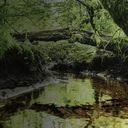

The elimination of ground cover, specifically purple moor grass, by forestry mulching. An indication of overgrazing, the abundance of purple moor grass prevents other species from developing. Getting rid of it allows for a diverse range of plants to take back their natural habitat.
The thinning of vegetation in the midst of overgrown natural habitats and young, peripheral woodlands. Manual logging, primarily among willows and birches, is carried out on the edges and in wooded wetland areas.
The cultivation of ideal conditions for amphibians (and wildlife in general) creates favorable environments for their reproduction. Aquatic insects and dragonflies will also benefit from these newly formed ponds. Their creation will contribute to create a network of wetlands relevant to the ecological continuity of the area.
The preservation of herbaceous plants on the moors, prairies, and fallows ensures a myriad of necessary habitats for certain heritage species. It will also prevent the progressive loss of these types of habitats which otherwise can occur if the surroundings are not humid enough for trees to thrive.
Contribute to 2.4 m2 of biodiversity
Amount:
10€Contribute to 4.8 m2 of biodiversity
Amount:
20€Choose your impact